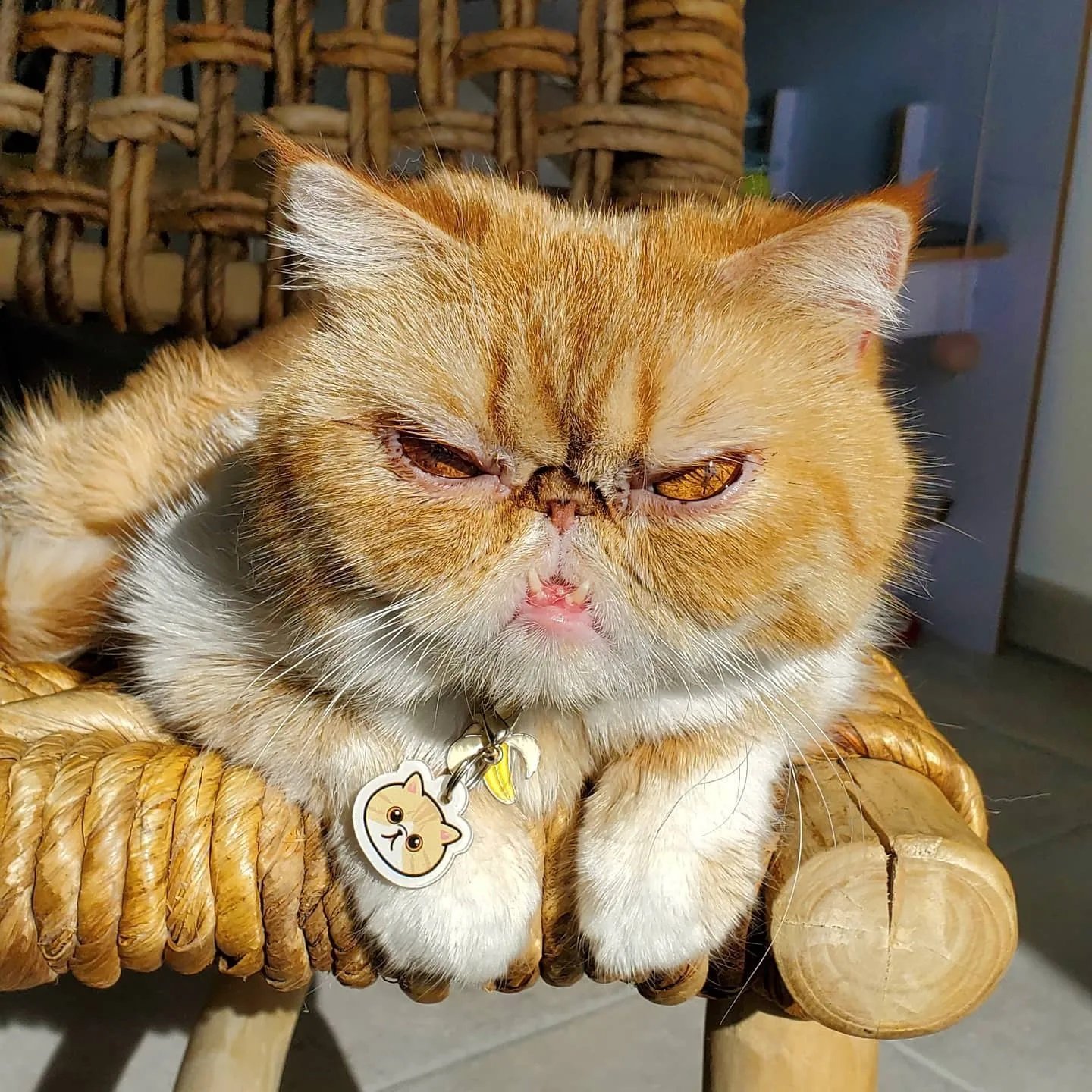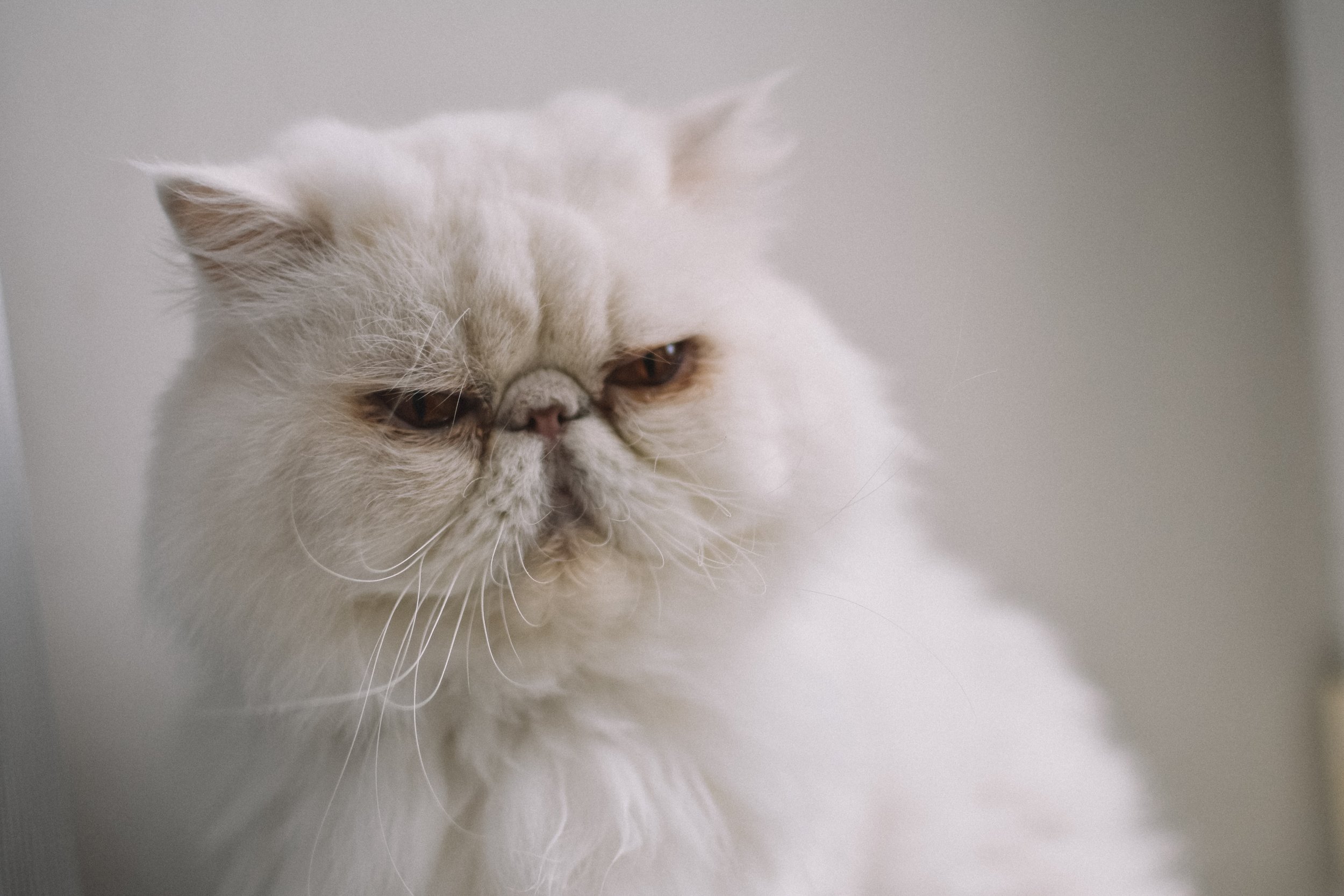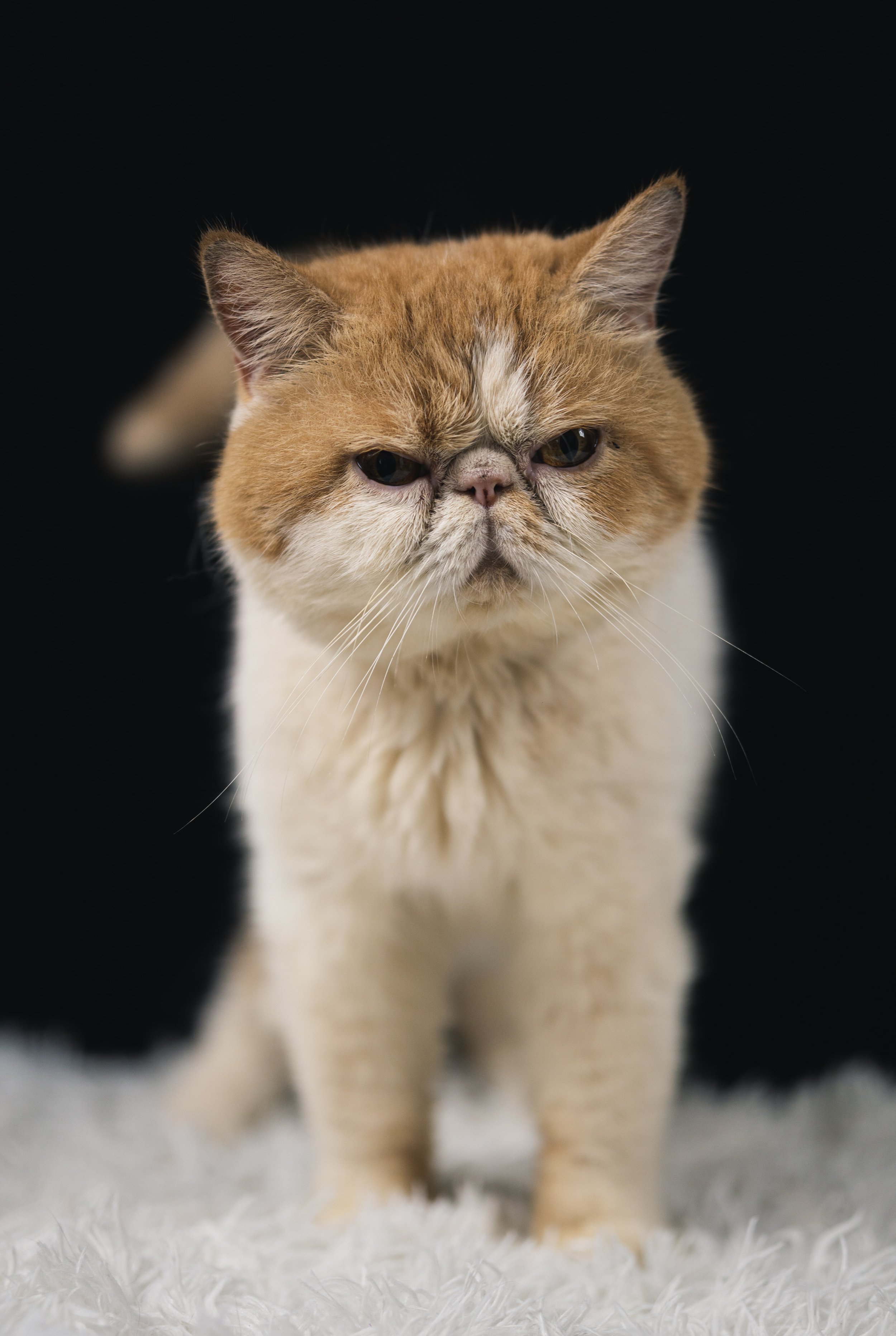Persian cats: Is it too late for the breed?
When I covered ethical breeding, I mentioned that breeders of cats with an extreme type are not responsible. In today’s article, I’m going to talk about probably the most known case of hypertype in cats: the Persian. Persian cats are brachycephalic, meaning that they have a flat face compared to the average domestic cat. We are going to discuss the health consequences of their flat face and if this breed can be considered ethical.
What’s a brachycephalic cat?
Brachycephalic literally means “short head”, and it refers to cats having a flatter face than the average morphology of domestic cats.
Cat breeds that are generally considered brachycephalic are the Persian, Exotic Shorthair (a short hair version of the Persian), American Burmese, Scottish Folds, British Shorthair/Longhair, Selkirk Rex.
However, the most extreme cases of brachycephaly are found in the Persian and Exotic Shorthair breeds.
There are different ways to classify the brachycephaly of cats. In this article, I will group brachycephalic cats into two categories:
Low grade of brachycephaly: That’s the case of the American Burmese, Scottish Folds, and British breeds, as well as traditional types of Persian and Exotic. These old types of Persian are called “doll-face” or traditional type. Their head is rounded and the size of their nose is reduced, with a distinct stop.
High grade of brachycephaly: That’s the case of modern types or “ultra-type” Persian and Exotic Shorthair. They are also sometimes called “peke-face” in reference to the Pekingese brachycephalic breed of dog. The tip of their nose is at a higher level than the bottom of the eye. The upper canine teeth are rotated and almost horizontal, there is a reduction of the facial bones and the stop of the nose is very pronounced. That way the forehead, nose, and chin are vertically aligned.
The flatter the face, the more the jaw is rotated and the narrower is the nasal airways and nostrils. [2]
3D head model of different head morphology from [6]
Breathing issues
Some of the side effects of brachycephaly are easy to understand: among these, there are breathing issues. This type of side effects is grouped under the term “BOAS” for Brachycephalic Obstructive Airway Syndrome. In fact, because of their morphology, brachycephalic cats have smaller and malformed airways compared to normal cats.
In dogs, this syndrome is well documented and can reduce the quality of life and lifespan of the affected dogs. [4]
Recent studies have shown that—like for dogs—cats are affected too and brachycephalic cats are more likely to have issues breathing and to make noise while breathing. These cats are also less active: this is very likely because they are limited by their breathing abilities. In fact, as observed in several studies, the owners of Persians reported lower energy and exercise levels for their cats than owners of other cat breeds. [2][4][12][13]
In severe cases, surgery may be needed to mitigate these issues. [17]
(a) normal nostrils, (b) to (d) mild to severe narrow nostrils from [11]
Teeth issues
The mouth of the Persian is also affected by brachycephaly. The smaller size of their mouth causes crowding of the teeth and frequent malocclusion. The higher the grade of brachycephaly, the more the jaws are distorted in a bow shape and the more the canine teeth are rotated in the mouth to the point of being almost horizontal instead of vertical.
This leads to increased risks of dental disease such as tooth resorptions and periodontal disease (tartar and dental plaque). The mastication can also be hindered, preventing them from being able to eat normally. [7][10][12]
Cat with severe malocclusion and mandibular prognathism from @ethicalcats
Obstruction of the nasolacrimal system
Discoloration of the fur and skin due to teardrop can happen in both doll-face or ultra-type cats. This is often considered a maintenance and cosmetic issue by Persian breeders and owners. However, this is a sign of health issues, as it can lead to facial irritation and infections.
In fact, because of their face deformation, the nasolacrimal duct is either abnormally-shaped to avoid the root of the canine teeth or, sometimes, entirely obstructed. This leads to excessive teardrops. [2][4][10]
This tear issue—combined with their large eyes and shallow eye socket—causes other ophthalmic issues such as non-healing corneal ulcers, entropion, and decreased corneal sensitivity. [11][12]
Even cats with a low grade of brachycephaly are susceptible to have narrow nostrils and excessive teardrops.
Fur length
The Persian is the breed with the longest fur, which is composed of two layers: a topcoat for protection and an undercoat of guard hairs for warmth. However, the combination of the mouth malformation and extremely dense coat makes it impossible for the cat to groom itself correctly. The amount of fur needs a huge dedication from the owners who often don’t have enough time to take proper care of it.
For this reason, Persians have a higher reported haircoat disorder compared to other breeds. [1][10]
“Upon request, breeders and owners often describe their cats as ‘dummies’, sometimes running into objects or falling from the windowsill.”
Neurocranial abnormalities and mental issues
Persian cats not only have a flat face: their whole skull morphology is impacted too, affecting the morphology of their brain. This leads to a higher rate of hydrocephalus, a build-up of fluids in the brain. That’s an important cause of death in Persian kittens. Hydrocephalus in less severe cases can cause neurological defects, deafness, and pain.
It seems that breeding associations have claimed that hydrocephalus was not linked to brachycephaly. However, a recent study proves the contrary. [6]
While I’ve already presented many health issues of the Persian and Exotic Shorthair breeds, sadly there are more. A study has looked at the genetic signature of the Persian breeds and what makes them different from other non-Persian breeds. The region of their DNA with the most differences contains two genes CHL1 and CNTN6. In humans, a mutation of these genes is associated with mental retardation, behavioral disorders, as well as face and skull malformations. [5][14]
This discovery suggests that the most extreme type of Persian cats is not only caused by the selection of flatter faces but also likely by a genetic mutation causing their face malformation. While it was previously thought that it was a spectrum of head morphology, brachycephaly is not a normal face pushed to the extreme but a clinical symptom of a genetic disease. Ultra-type Persians have a feline form of coronal craniosynostosis, meaning that the bones of their skull join together too early in their development. [6][14]
This study also suggests that the calm and placid behavior of these cats is caused by mental retardation: these traits would have been selected so that the cats allowed long periods of grooming. [5]
This is coherent with the behavioral comparisons of breeds where Persian were reported as being uninterested in playing, or in social interactions with other cats or humans. [13]
3D reconstruction of skulls from [6]
“They are often uninterested in playing and have reduced social interactions with other cats and with the owner, which might imply more neurologic deficits than initially detectable. ”
What can be done?
Education
In a study, veterinary and animal care professionals had a lower preference toward extreme brachycephaly breeds. This shows that being aware of the health issues associated with the breeds decreases the preference towards them. In my opinion, education on these health issues is crucial in reducing the popularity of the Persian and Exotic Shorthair breeds. [8][9]
Cat fancy
One of the main issues is that, currently, the standards of the cat fancies encourage the ultra-type: several standards mention that the forehead, nose, and chin should be aligned on the same vertical line.
In a recent study published in 2021 where show cats were analyzed, 93% of the Persian and Exotics had the top of their nose above the lower eye-lid (which corresponds to an ultra-type): this really shows that it’s currently the desired type in exposition. Moreover, while 83% of the cats had excessive teardrop and 32% had entropion, none received any comments on their health from the judges. [11]
In 2021, at the general council of FIFÉ, it has been proposed to modify the standard to add the mention of “open nostrils” as well as a disqualification in case of “loud and difficult breathing”, but these propositions were rejected. [15]
We can see that currently, the majority of the breeders and cat fancies are not open to improving the breed.
However, it may not be too late to stop the selection of extremely typed Persian and to go back to a doll-face type. In the World Cat Federation, the Traditional Longhair breed (also called Original Longhair) has been recreated, which corresponds to the old-style Persian. [3]
Breeders, too, have already been able to improve the breed in the past. In fact, in the 1990s the prevalence of polycystic kidney disease—a hereditary genetic defect—was very prevalent in the breed, with 49% of affected cats. However, through DNA testing and selection, breeders have reduced this prevalence to 2% in 2016. This shows that targeted selection can effectively reduce health issues. [10]
As mentioned in the literature, we can hope that the cat fancies will act and modify the standards to encourage healthier cats. [3][6]
“However, if there are not meaningful moves away from the more extreme aspects of facial conformation in Persian (and Exotic) cats within a reasonable period (perhaps 5 years), the authors accept that specific legislation may be necessary e.g. that breeding cats with the top of their nose leather at or above the bottom of the medial canthus of their eye would be deemed animal cruelty.”
The law
As several studies suggested, if the fancies don’t act quickly (less than 5 years) to modify the standards, the breeding of brachycephalic hyper types should be outlawed. In fact, voluntarily breeding animals with malformations is animal cruelty. [1][3][10][14]
Additionally, if we consider the European Convention for the Protection of Pet Animals, the breeding of Persian cats should already be outlawed by the countries that ratified it. In fact, Article 5 states: “Any person who selects a pet animal for breeding shall be responsible for having regard to the anatomical, physiological and behavioral characteristics which are likely to put at risk the health and welfare of either the offspring or the female parent.”. [16]
Considering all the health issues of the Persians they are without a doubt putting at risk the welfare of the cats.
To conclude, Persians are predisposed to at least 29 diseases, many that I didn’t have the place to develop in this article. The breeding of ultra-type Persian should be stopped to prevent any cats from suffering. You can act and help raise awareness. Share this article on social media, contact your local cat fancy or legislator. In fact, it may be against your country’s welfare law to deliberately breed cats with disabilities.
More ressources on this subject
The ethics of breeding for deformity: extreme brachycephaly by MessyBeast
Lost breeds - peke-faced cat by MessyBeast
Sources
[1] Malik, R., Sparkes, A., & Bessant, C. (2009). Brachycephalia--a bastardisation of what makes cats special. Journal of feline medicine and surgery, 11(11), 889–890.
[2] Schlueter, C., Budras, K. D., Ludewig, E., Mayrhofer, E., Koenig, H. E., Walter, A., & Oechtering, G. U. (2009). Brachycephalic feline noses: CT and anatomical study of the relationship between head conformation and the nasolacrimal drainage system. Journal of feline medicine and surgery, 11(11), 891–900.
[3] Engberg L. (2010). Brachycephalic cats - is it too late for the Persian?. Journal of feline medicine and surgery, 12(1), 55.
[4] Farnworth, M. J., Chen, R., Packer, R. M., Caney, S. M., & Gunn-Moore, D. A. (2016). Flat Feline Faces: Is Brachycephaly Associated with Respiratory Abnormalities in the Domestic Cat (Felis catus)?. PloS one, 11(8), e0161777.
[5] Bertolini, F., Gandolfi, B., Kim, E. S., Haase, B., Lyons, L. A., & Rothschild, M. F. (2016). Evidence of selection signatures that shape the Persian cat breed. Mammalian genome : official journal of the International Mammalian Genome Society, 27(3-4), 144–155.
[6] Schmidt, M. J., Kampschulte, M., Enderlein, S., Gorgas, D., Lang, J., Ludewig, E., Fischer, A., Meyer-Lindenberg, A., Schaubmar, A. R., Failing, K., & Ondreka, N. (2017). The Relationship between Brachycephalic Head Features in Modern Persian Cats and Dysmorphologies of the Skull and Internal Hydrocephalus. Journal of veterinary internal medicine, 31(5), 1487–1501.
[7] Mestrinho, L. A., Louro, J. M., Gordo, I. S., Niza, M., Requicha, J. F., Force, J. G., & Gawor, J. P. (2018). Oral and dental anomalies in purebred, brachycephalic Persian and Exotic cats. Journal of the American Veterinary Medical Association, 253(1), 66–72.
[8] Farnworth MJ, Packer RMA, Sordo L, Chen R, Caney SMA, Gunn-Moore DA. In the Eye of the Beholder: Owner Preferences for Variations in Cats’ Appearances with Specific Focus on Skull Morphology. Animals. 2018; 8(2):30.
[9] Plitman, L., Černá, P., Farnworth, M. J., Packer, R., & Gunn-Moore, D. A. (2019). Motivation of Owners to Purchase Pedigree Cats, with Specific Focus on the Acquisition of Brachycephalic Cats. Animals : an open access journal from MDPI, 9(7), 394.
[10] O'Neill, D. G., Romans, C., Brodbelt, D. C., Church, D. B., Černá, P., & Gunn-Moore, D. A. (2019). Persian cats under first opinion veterinary care in the UK: demography, mortality and disorders. Scientific reports, 9(1), 12952.
[11] Anagrius, K. L., Dimopoulou, M., Moe, A. N., Petterson, A., & Ljungvall, I. (2021). Facial conformation characteristics in Persian and Exotic Shorthair cats. Journal of feline medicine and surgery, 23(12), 1089–1097.
[12] Sieslack, J., Farke, D., Failing, K., Kramer, M., & Schmidt, M. J. (2021). Correlation of brachycephaly grade with level of exophthalmos, reduced airway passages and degree of dental malalignment' in Persian cats. PloS one, 16(7), e0254420.
[13]Mikkola, S., Salonen, M., Hakanen, E., Sulkama, S., & Lohi, H. (2021). Reliability and Validity of Seven Feline Behavior and Personality Traits. Animals : an open access journal from MDPI, 11(7), 1991.
[14] Schmidt, M. J., Farke, D., Staszyk, C., Lang, A., Büttner, K., Plendl, J., & Kampschulte, M. (2022). Closure times of neurocranial sutures and synchondroses in Persian compared to Domestic Shorthair cats. Scientific reports, 12(1), 573.
[15] FIFe General Assembly - 2021
[16] European Convention for the Protection of Pet Animals (ETS No. 125)
[17] Corgozinho, K. B., Pereira, A. N., Cunha, S. C., Damico, C. B., Ferreira, A. M., & de Souza, H. J. (2012). Recurrent pulmonary edema secondary to elongated soft palate in a cat. Journal of feline medicine and surgery, 14(6), 417–419.






